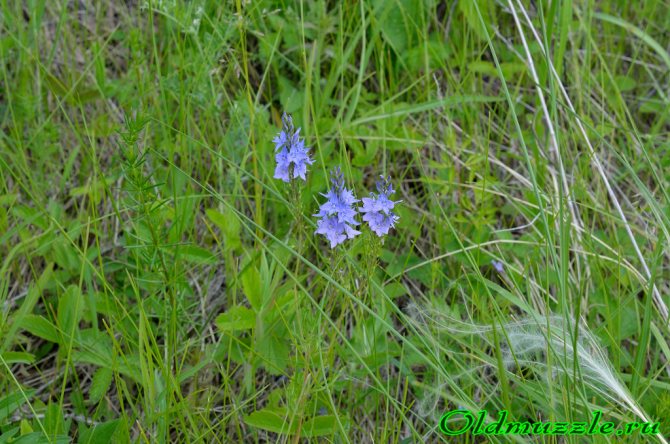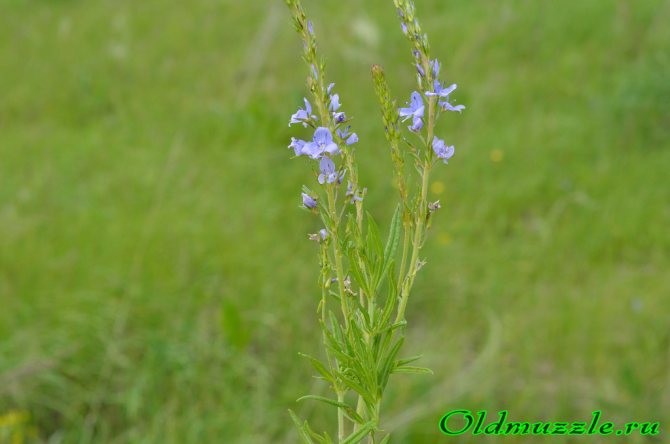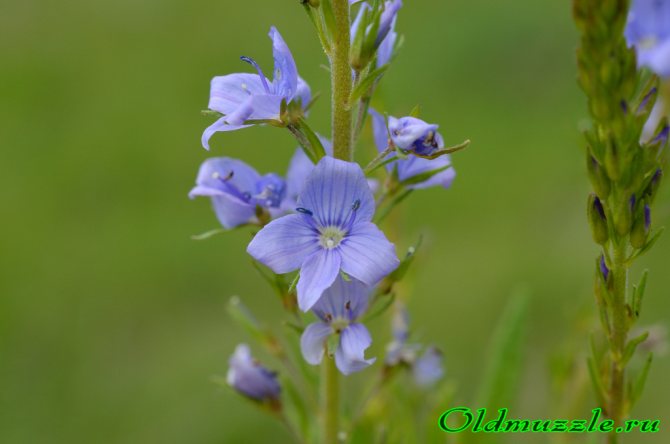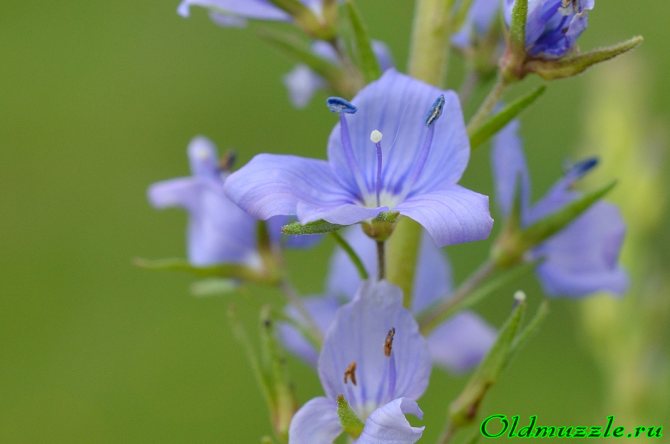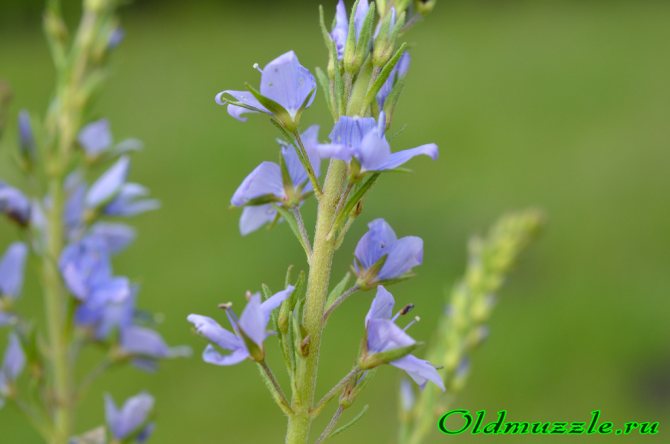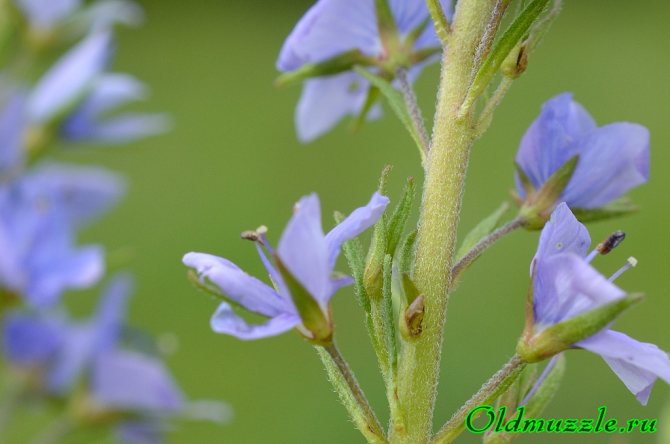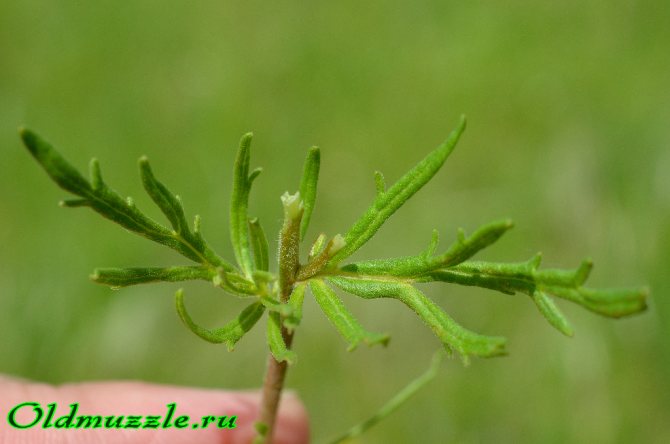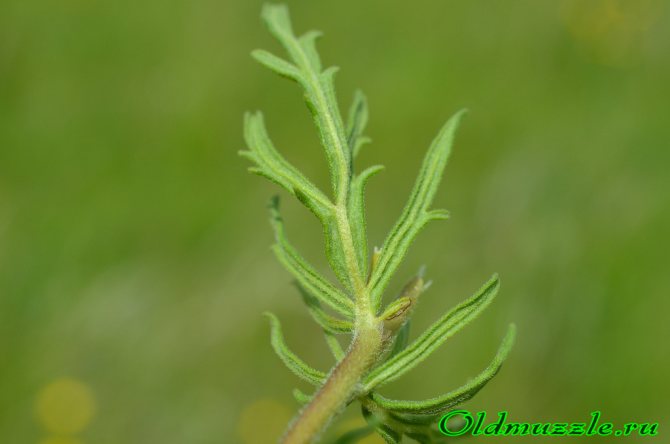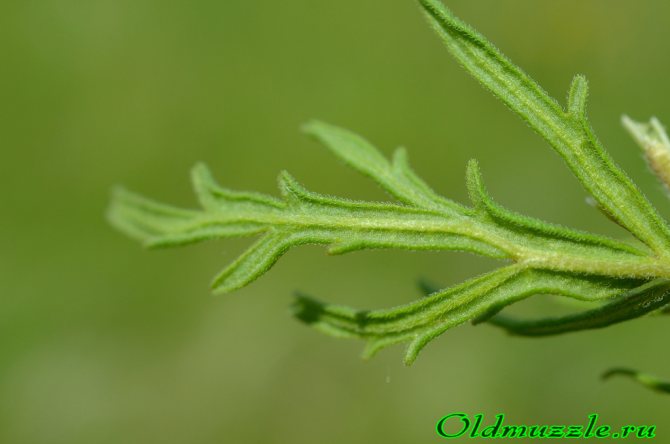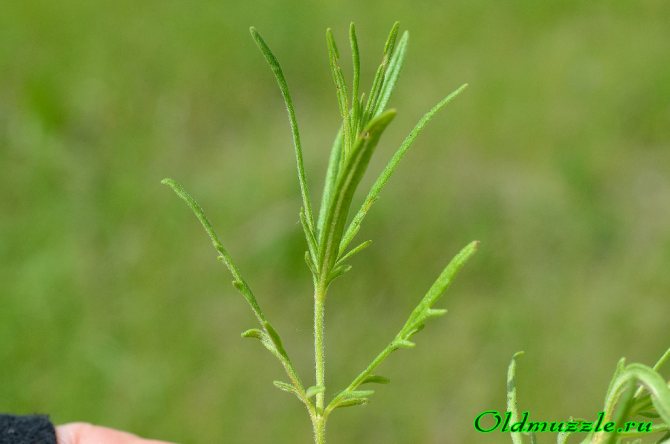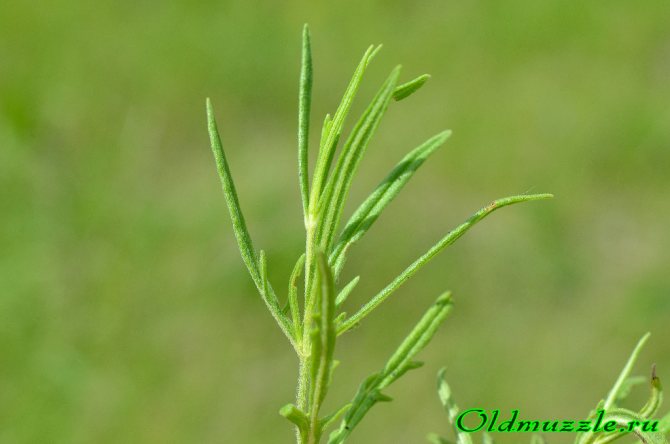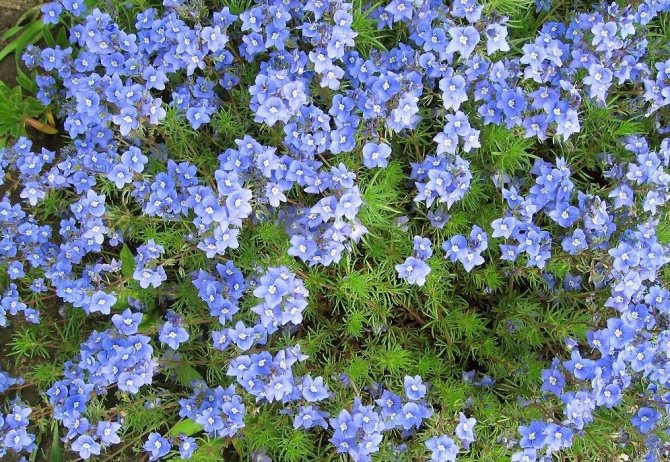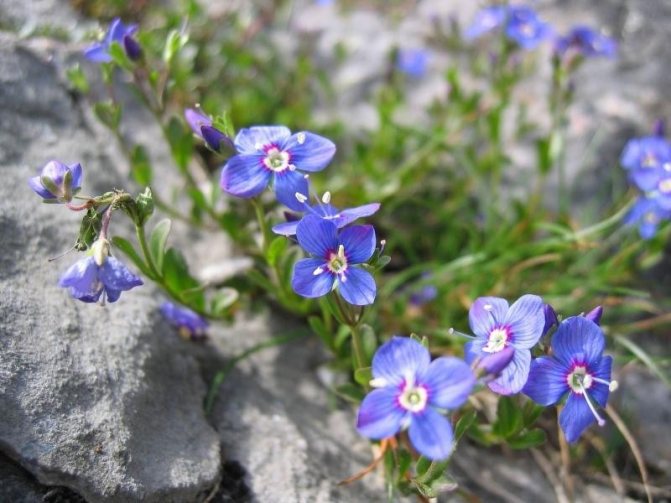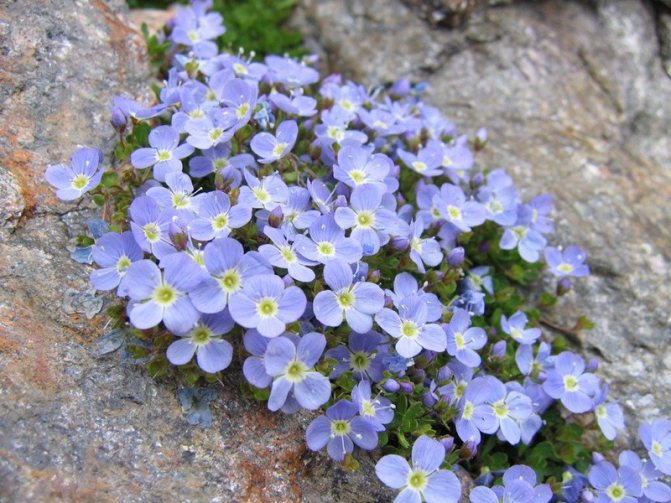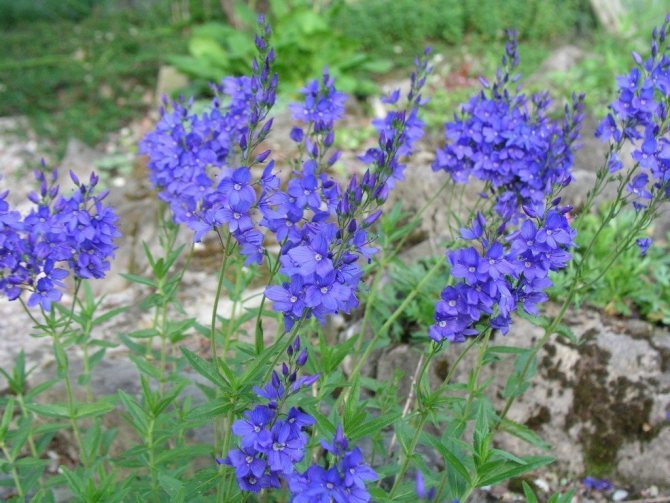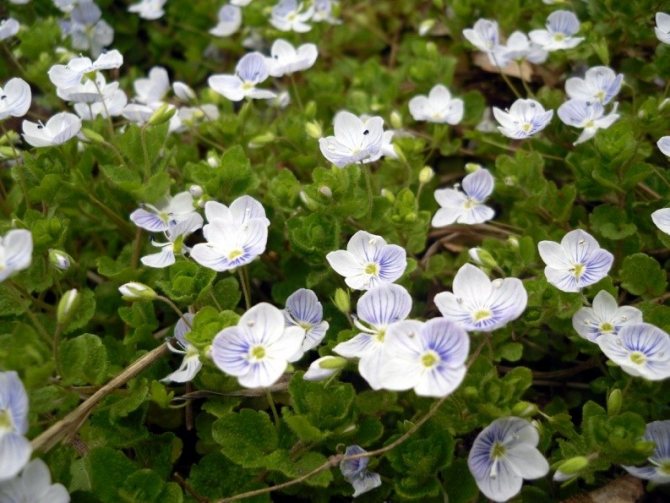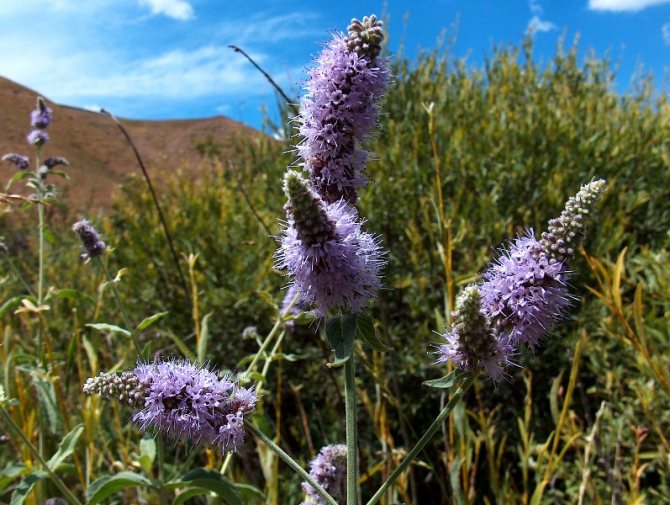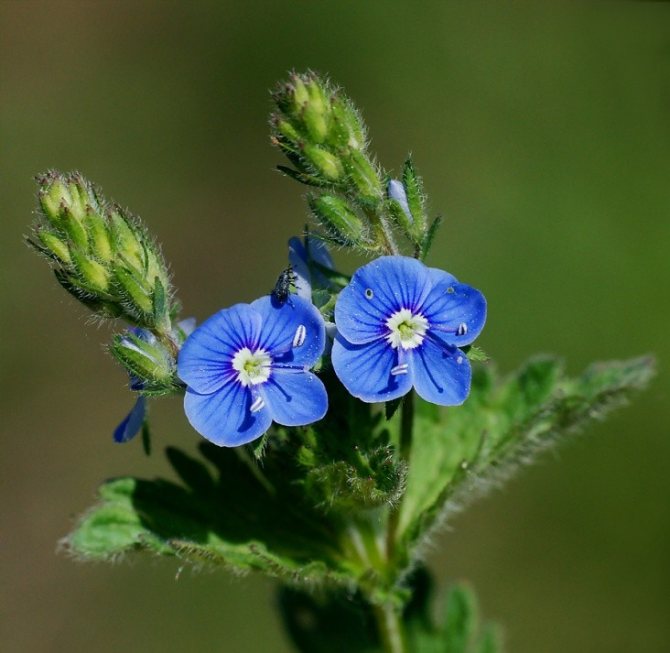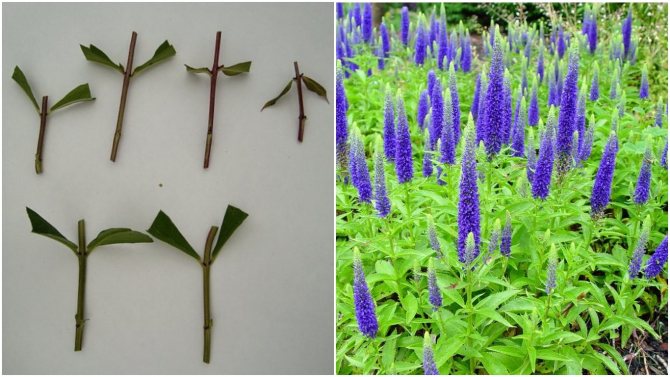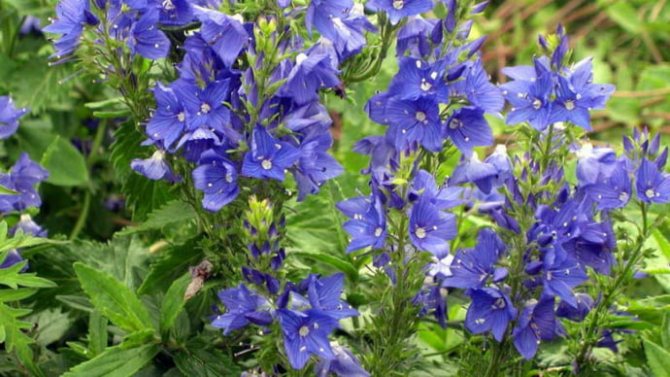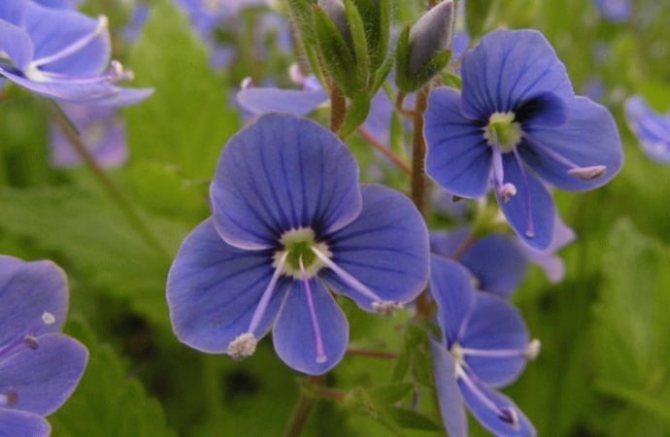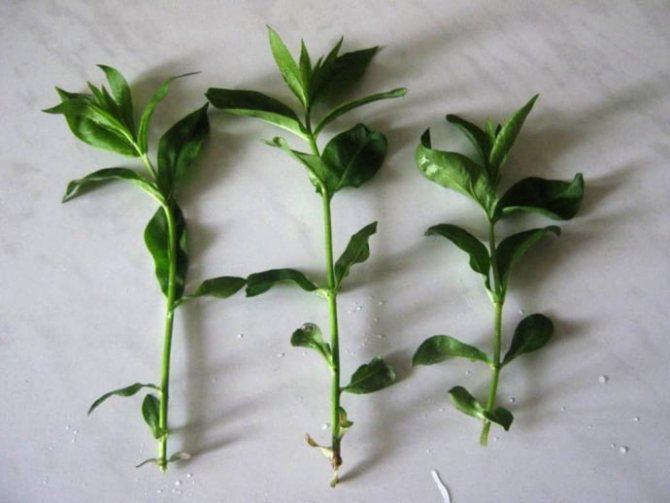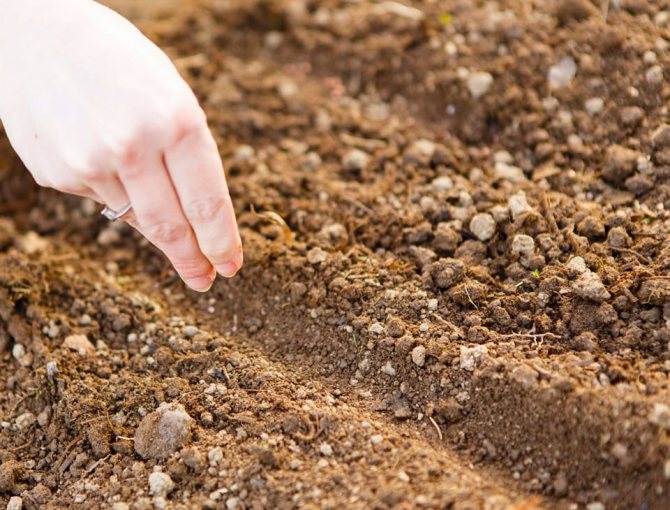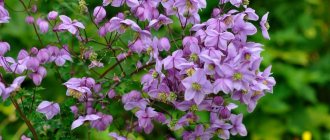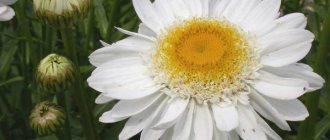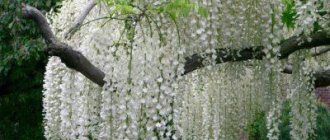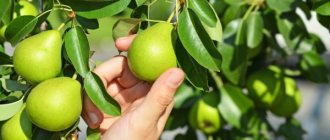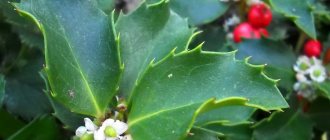Veronica filamentous, or filamentous, is the most delicate herbaceous plant. It is a perennial with airy white or bluish flowers. Many gardeners simply struggle with such a plant, expelling it from their site. It is extremely difficult to care for these flowers, especially to keep them in a certain zone for growing, - the perennial is actively growing, turning almost into a real problem. Such energy in the growth and vitality of the plant can be directed in the right direction and used to its advantage.
Description
The plant acquired its name not at all from a beautiful female name. It has Latin roots and consists of two words - vera and unica, which means "real medicine." Indeed, it is used in medicine. By the way, Veronica is a relative of the plantain, well known to everyone from childhood, which was actively used in the treatment of minor wounds.
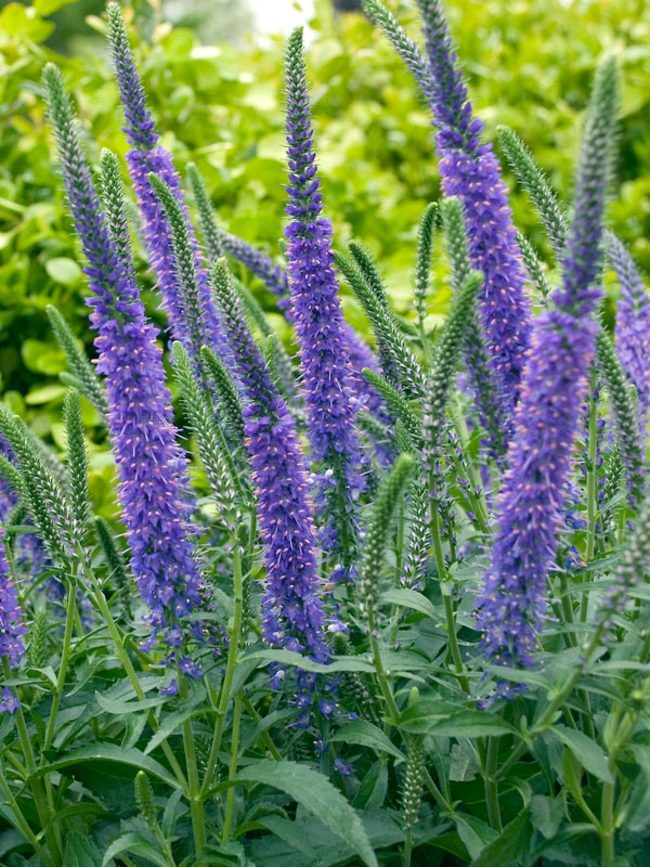
Most varieties are herbaceous. However, there is also a veronica plant, a photo of which you can see in the article, in the form of small shrubs. Many varieties are perennial; there are relatively few annuals.
Outwardly, the varieties are very different from each other - there are high and low, erect and creeping. The arrangement of the leaves can be alternate and opposite.
However, all varieties have one thing in common - the structure of flowers. The flowers themselves are quite small, but they are collected in a large tube that catches the eye. The range of colors is quite rich. Although mostly blue and light blue flowers and all their shades are found, white and pink can also be found if desired.
After flowering, small capsules containing seeds appear on the tube - they can be collected to plant next year in a suitable place.
Features of caring for the area where filamentous grass grows
Veronica can be easily harvested by hand if the plant grows too large or simply becomes unnecessary. There should be no problems with cleaning the lawn, except that Veronica has been growing there for more than one year and her roots are too intertwined. Then you will have to use garden tools, removing flowers along with the top layer of soil. Carrying out such work, it is necessary to ensure that not a single shoot of the filamentous or creeping Veronica remains in the soil, the photo of which can be seen in the article, otherwise the extremely fast growing flowers will again fill the entire area.
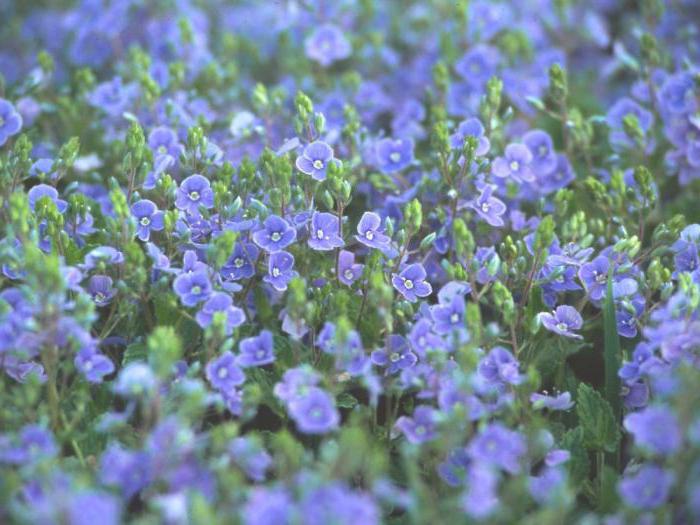

Using such a plant as a landscape decoration will add tenderness and ease to the site. Such a lawn or garden will look spectacular, and individual landscape compositions will be complete. By caring for and observing the growth of the grass, you can control it, creating an amazingly beautiful composition.
Most popular varieties
In total, today there are about 300 varieties of this plant. Some appeared thanks to the efforts of nature, while others were bred by diligent breeders. Let's talk about some of the most interesting varieties so that the novice gardener can choose the option that suits him.
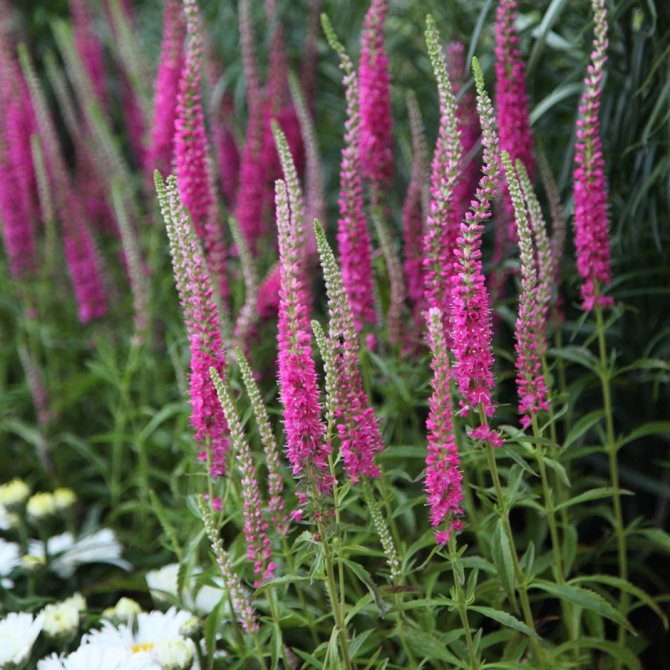

Veronica large is the most common wild-growing variety in our country. You can meet it not only in the European part of Russia, but also in Siberia, the Mediterranean, and even Western Europe. Single stems are quite long, up to 70 centimeters. The leaves are opposite.The flowers are blue or light blue. Very unpretentious. It grows well on almost any soil, tolerates winter frosts without harm to itself. But still he loves the sun and moisture. It begins to bloom in early or mid-May. Flowering lasts about 30 days.
Veronica Dubravnaya boasts quite large flowers - up to 10 mm in diameter. For a short plant (about 40 cm), this is a very good indicator. The flowers are blue, blue, but also pink. Easily tolerates autumn frosts - even under the snow, it does not always shed leaves. Distributed in Siberia and in many European countries.
Veronica spikelet is also not too tall - no more than 40 cm. It has single, pronounced stems. It begins to bloom in June and usually the process is delayed for 35-40 days. The range of colors is quite rich. This variety of Veronica flowers can be blue, purple, blue, pink, white. In the wild, you can find it not only in our country, but also in Western Europe.
Beneficial features
Veronica officinalis in traditional medicine is used as an anti-inflammatory and expectorant agent for gastrointestinal diseases, in folk medicine - for pulmonary pathologies, inflammation of the bladder, stomach and kidneys, adrenal diseases, headaches, rheumatism, to stimulate appetite. Externally used for burns, wounds, skin diseases. Veronica Dubravnaya is used in food as a substitute for watercress, adding it to salads, soups, and also as a side dish for fish and meat.
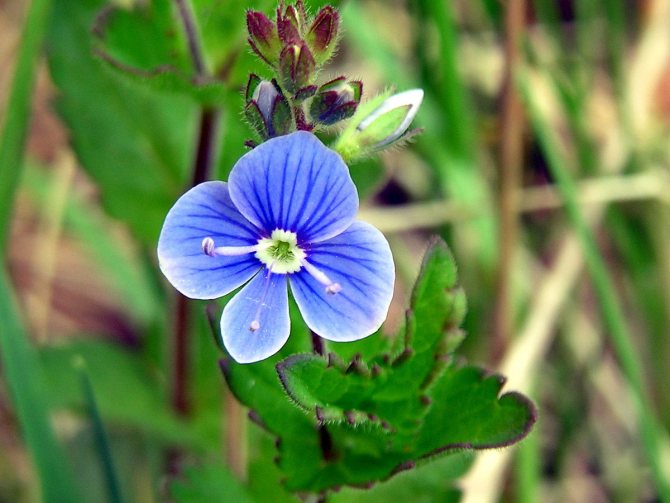

Veronica Dubravnaya
Planting seedlings
If you decide to plant a veronica flower on your site, planting and care will not cause much trouble. But nevertheless, it will be very useful to study the theory.
If you want to use seeds (we'll talk about other breeding methods a little later), then it would be better to grow them at home first.
First, the seeds are removed in the refrigerator for 1-2 months. We take them out in mid-March and get to work. It can be planted both in separate cups and in one common container. The seeds are quite small, but still allow you to plant yourself, not sow. Try to place one seed in each cup, or at 5cm intervals in one container. Otherwise, the plants will interfere with each other, crush.
After planting, the soil is watered and covered with foil to create a greenhouse effect. The seedlings are kept in a warm, dark place. After the first sprouts appear, the film is removed, and the seedlings are placed on the windowsill - the main thing is not to blow it in a cold draft.
When the seedlings have 8-10 leaves, they can be planted in the ground.
Features of Veronica's agricultural technology: growing and care
Veronica is loved by gardeners for her unpretentiousness, lack of special techniques, variety of species and varieties. If Veronica is chosen as a resident of a flower bed, then you should remember the basic rules for any perennial plant.
Important requirements that cannot be circumvented:
- Sunny side of the site, where the light will be present from morning to evening. Shady and semi-shaded areas will not give those decorative properties that are declared by breeders.
- Pay attention to watering: each species requires a certain amount of water. When breeding Veronica, you need to get acquainted not only with the decorative value, but also with the conditions of care. Herbaceous creeping species do not tolerate drought, die without water, flowering ceases. Erect tall species can easily withstand drought and heat.
- Liquid organic fertilizers act as top dressing during the period of budding and flowering. In nature and wild breeding, it does well without additional feeding. Soil nutrients are sufficient for growth and flowering. Beds with depleted soil can be fed with organic matter: humus, manure, infusion of nettle and burdock.
- Tall bushes need a garter.A thin stem does not withstand the pressure of the wind, which can not only tilt downward, depriving the aesthetic appearance, but also break. Twigs, picket fence, willow branches will do.
- In autumn, after the end of flowering, the ground part is cut off, the roots are additionally covered with humus, peat, dry foliage, spruce branches, creating a pillow that will protect against abnormally low temperatures.
Preparing to disembark
As you can see, the initial stage of growing a Veronica flower does not cause much trouble. Now you can proceed to the next step - planting in the ground.
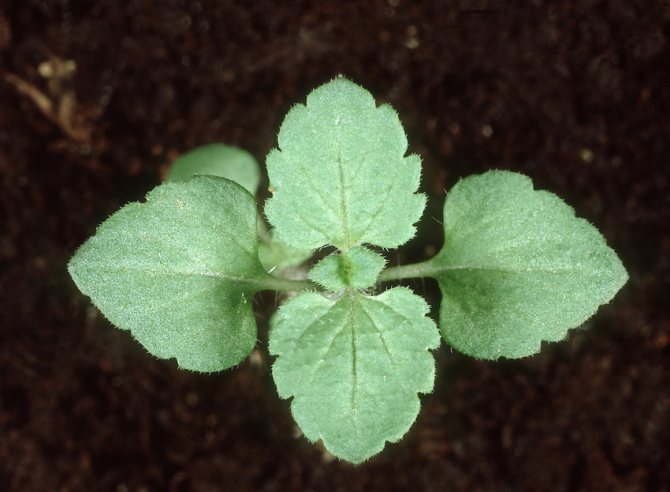

Before this, the seedlings are taught to be kept on the street. The easiest way to do this is to start taking the container out to the balcony in mid - late April, starting with the hottest hours. First for an hour, the next day for two. As a result, after two weeks, you can safely leave the seedlings on the balcony around the clock.
Plants are planted in the soil when it has warmed up enough. It will not be superfluous to add mineral fertilizers, primarily phosphorus. It promotes the formation of a powerful root system and significantly speeds up the rooting process. This means that the plant will develop faster and will soon delight you with gorgeous flowers.
Varietal variety
The Veronica genus includes hundreds of species, so from this variety you can always choose a variety, the characteristics of which will best meet the wishes of the grower. There are several types that can be used to decorate the site:
Veronica armena (v. Armenian)... Low-growing (up to 10 cm) creeping plant. It has needle-like leaves and blue flowers that resemble forget-me-nots.
Veronica caucasica (Caucasian veronica)... The stems and leaves of this species are colored bright green, while the lower part is darker than the upper one. The leaf is small, elongated, with denticles along the edge. Flowers are painted mainly in dim colors, lilac or purple, with thin veins of purple. Grows well in rocky ground, quickly recovers after trampling.
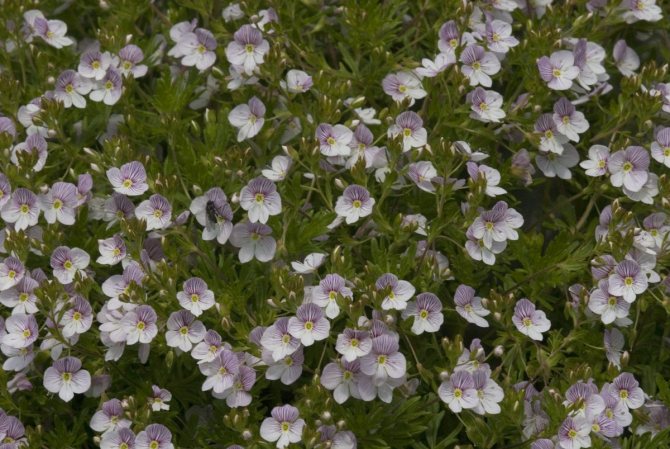

Veronica caucasica (Caucasian veronica)
Veronica teucrium (v. Broadleaf or large)... Height up to 0.7 m, erect pubescent stem. The roots are strong, do not freeze in winter. The leaf plate is smooth above, covered with hairs below. The inflorescence is paniculate, painted in pink, lilac, blue tones.
Veronica gentianoides (v. Gentian)... This species has a long flowering period. The leaves of the plant are mainly concentrated at the base, they are silvery-green, with a light edging, the flowers are white with blue stripes.
Veronica surculosa (Veronica woody)... In this species, the stem is creeping, it stiffens in the spring. Cold-resistant perennial plant. The color of the flowers is from pink to purple.
Veronica taurica (v. Crimean)... Looks good on alpine slides. Loves a mild, stable climate without sudden changes in temperature. The flowers are bright blue, the leaf is dark green.
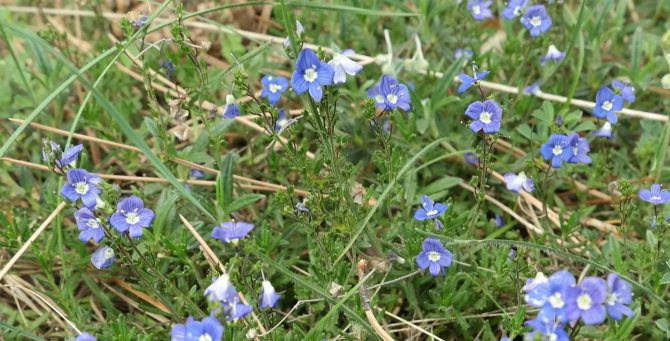

Veronica taurica (v. Crimean)
Veronica filiformis (v. Filiform)... The species belongs to primroses, flowering occurs approximately in mid-April. The leaf is pale green in color, the flowers are light blue.
Veronica incana (v. Gray-haired)... A distinctive feature of this species is its silvery stem and leaves. The flowers are deep blue.
Veronica peduncularis (v. Peduncle)... Herbaceous perennial, bush height up to 0.3 m. It blooms profusely, with blue flowers with a yellow center.
Veronica longifolia (v. Long-leaved)... The bush is high, up to 1.5 m, the stem branches into several peduncles in the upper part. Flowers in lilac-blue tones.
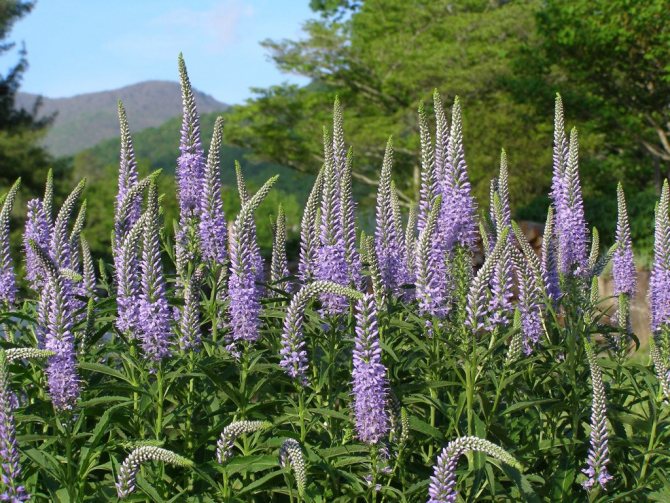

Veronica longifolia (v. Long-leaved)
Veronica officinalis (v. Medicinal)... In addition to decorative, it also has medicinal value, decoctions and infusions are prepared from it.
Veronica prostrata (v. Stretched out)... The bush is from 5 to 30 cm high. The stems are pubescent, grayish, the flowers are pale blue or bluish-purple.
Veronica anagallis-aquatica (v. Key)... Bush 0.1 - 1.5 m high, with straight, simple or branching stems. The flowers are small, whitish to dirty purple in color, with a yellow ring.
Veronica jacquinii (v. Jacquin)... Perennial, forms a bush 0.15 - 0.6 m, blooms in May-August.
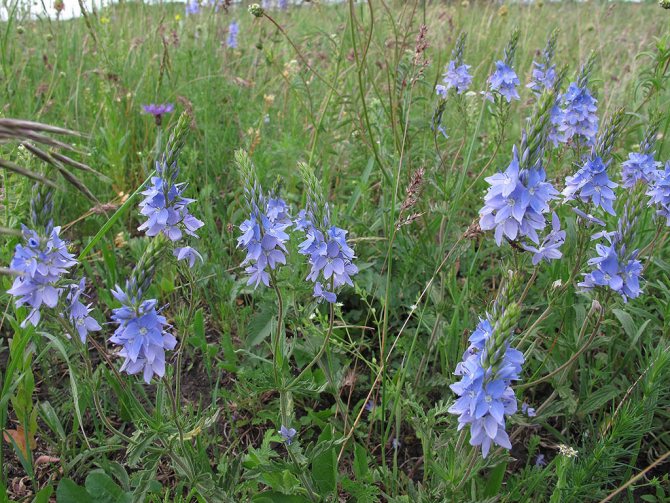

Veronica jacquinii
Verónica spicáta (v. Spicate)... The bush is from 0.15 to 0.75 cm high, the stems are simple, strong, green or grayish from pubescence. Forms a dense raceme 5-30 cm long, the flowers are blue or bright blue, rarely white, pink, purple.
Veronica siberica (v. Siberian)... The bush grows up to 0.4 - 1.5 m. It has strong branching stems, blue flowers are collected in long inflorescences.
Veronica chamaedrys (v. Oak)... The bush is from 0.1 to 0.5 m high. The stems are creeping, rooting, the flowers are bright blue with dark veins, collected in loose brushes.
Veronica austriaca (v. Austrian)... The plant is from 0.3 to 0.7 m tall. Stems are erect or erect. Bright blue flowers arranged in elongated racemes.
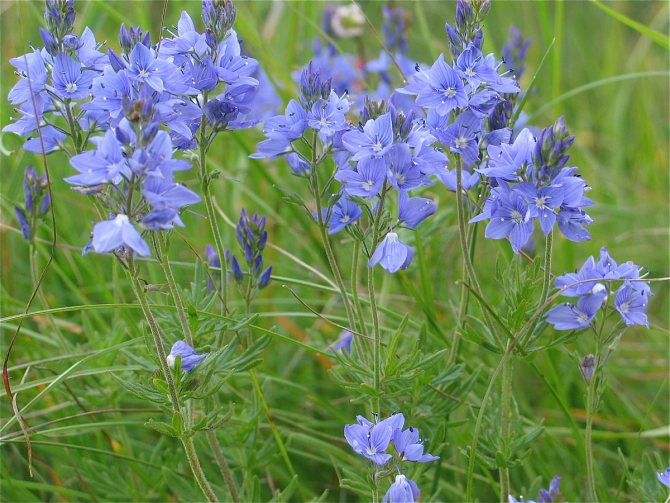

Veronica austriaca (v. Austrian)
Veronica beccabunga (v. In-line)... Plant height 0.1 - 0.6 m, erect branched stems. The flowers are often pale blue with blue stripes or dark purple.
In addition to herbaceous forms, Veronica can be shrubby. These are perennials that can be planted not only in a flower bed in the garden, but also placed in portable containers.
Sowing in the ground
Some gardeners who do not want to spend too much time on leaving, planting a Veronica plant, prefer to plant seeds directly into the ground.
There can be two options here - autumn and spring planting. Each of them has certain characteristics.
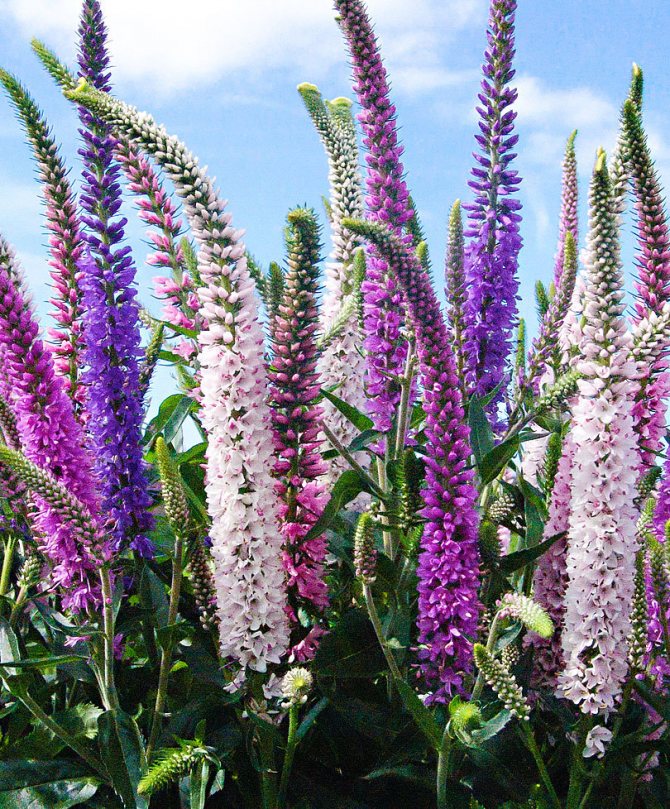

First of all, you need to choose a suitable place. Veronica loves open areas that are rich in sun. Not afraid of wind and excessive heat, especially if you regularly water the flower bed.
If you prefer to plant seeds in the spring, then they must first be stratified. The easiest way to do this, as mentioned above, is by putting a paper bag of seeds in the refrigerator for a couple of months. On flower beds it is not worth overly deepening them - it is enough to sprinkle it with soil a couple of centimeters so as not to complicate germination once again.
When planting in autumn, the seeds are planted directly into the ground - they do not need additional processing, because during the winter, the soil will freeze and stratification will occur naturally.
The distance between the holes should be at least 10-15 centimeters. Otherwise, the grown plants will crush each other - the weak will die, and the strong will weaken.
Seeds
Sowing of the material is done in late autumn. Flowering occurs 24 months after the planting of filamentous Veronica plants. Seeds in the case of spring sowing lend themselves to stratification - a procedure that consists in creating an artificial temperature difference necessary for normal seed germination.
The process of growing a plant from seeds looks like this:
- Prepare a garden pot with a drainage substrate.
- Seeds are spread on the surface, sprinkled on top with a small amount of earth.
- Crops are sprayed with water. The top is covered with a film with small holes, allowing the seeds to get access to oxygen.
- The pot with planting material is placed in a cooler place in order to create special conditions for seed germination (for example, in a refrigerator), where it is kept for the next 3 weeks.
- After this period, the container is moved to a well-lit warm place and wait for the first shoots, which begin to hatch 2 weeks after the temperature change. They take care of the seedlings according to the standard method.
The seeds of the filamentous veronica are freely available, and you can buy them at any specialty store.
Reproduction by division
There are other ways to reproduce the Veronica flower. For example, division is popular among florists.
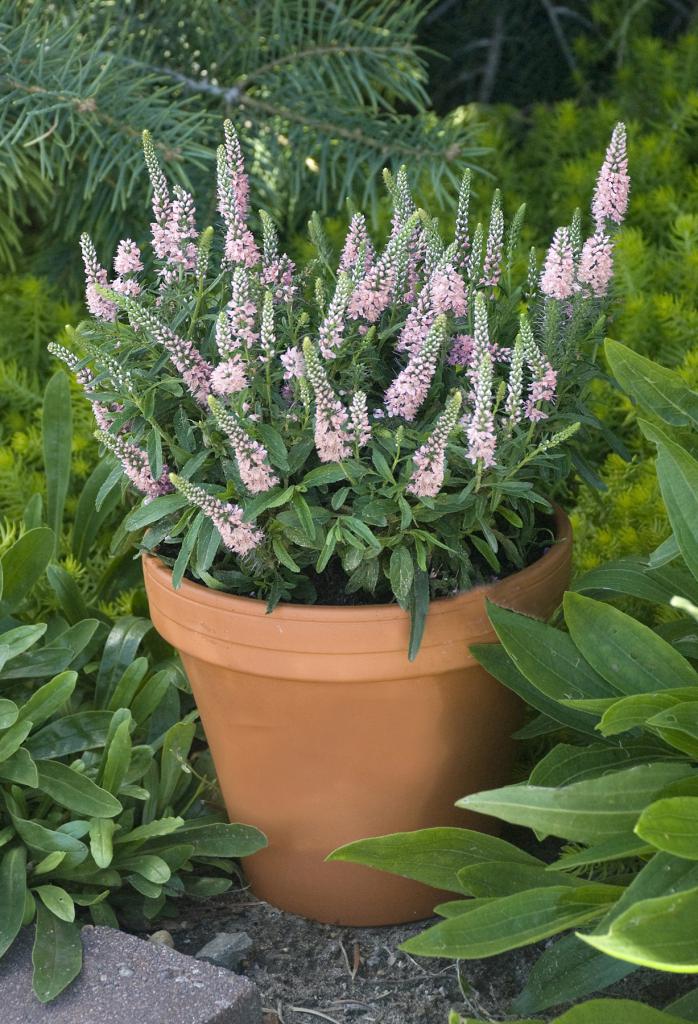

Most varieties of Veronica are perennial, so you can take not seeds, but ready-made bushes. Division is allowed in late April - early May (before flowering), but better - in the fall, before wintering.
To do this, select a large bush, carefully dig it out of the soil and divide it in two with a garden knife. Then transplant both seedlings to a suitable location. It is advisable to fill the wells with compost, chernozem, or simply fertilize with phosphorus fertilizers.
After transplanting, cover the bush to protect it from the wind and excess sun - the latter is especially dangerous. Without a developed root system, the plant can simply dry out. After ten days, the covering material can be removed - usually during this time the plant acquires a powerful root system. Further care is as simple as possible - it is enough to regularly water the flower bed and loosen the ground.
The place of the plant in landscape design compositions
Sometimes the plant is sown on its own on the territory and does not have to be planted. The grass grows instantly. The most delicate plant of amazing beauty is threadlike veronica. Herbaceous plants for open ground can not be bought from hands, you can not look for seeds in garden stores, but you can bring them from the usual habitat of flowers: forests or meadows. It is often used as an element of the design of landscape compositions, especially in those cases when the site is to be decorated in a relaxed natural style.
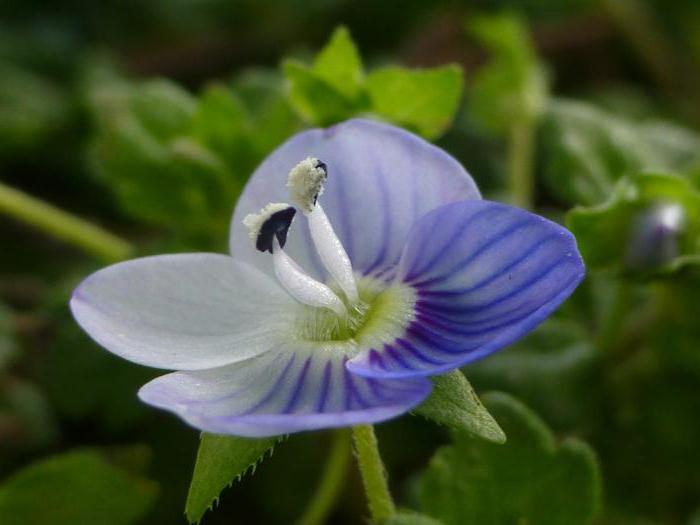

These ground cover flowers can easily be planted under berry and fruit trees. There is no reason to worry that the grass will draw out all the nutrients from the soil and cultivated plants themselves. Such an impromptu carpet in the garden will help keep the fruits falling from the trees safe and sound. In hot summer, the plant retains moisture in the soil longer, protecting it from overheating, therefore, trees and bushes growing around them receive more nutrients and moisture.
The herbaceous plant creates a living carpet underfoot, which is pleasant to walk on barefoot. Such a lawn covering is not only practical, but also beautiful. A small herbaceous plant can be easily cut with a lawn mower, trimmer, or garden shears. It should be noted that this plant is capable of suppressing the growth of weed species.
Important! The area, abundantly overgrown with filamentous Veronica, looks spectacular not only during the flowering period of the plant, but also after its end. Light green leaves give the site a fresh look, create coziness and additional comfort.
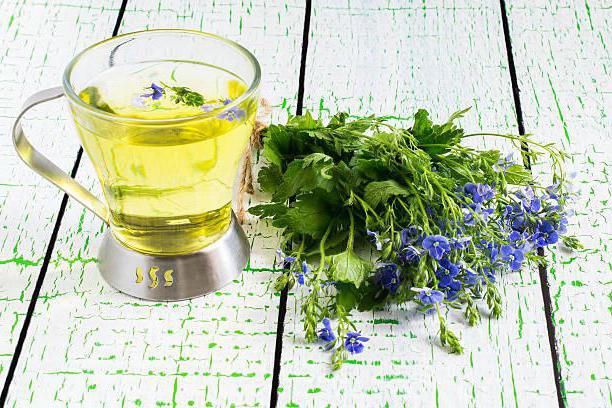

The bundles of filamentous Veronica growing between the stones of the retaining walls of the rock gardens look spectacular. But such compositions already need to be controlled, otherwise the grass will grow all over the hill and simply ruin the landscape composition.
Propagation by cuttings
Another reliable way to get a new plant is by using cuttings. Usually cuttings are made in mid-August. A shoot is cut from a healthy, robust plant with the desired characteristics. The optimal length is 10-12 centimeters.
Now he needs to be allowed to germinate. Some prefer to germinate cuttings in water, while others keep it in a root solution for half a day, and then transplant it into a nutrient soil. In the latter case, you need to cover the pot with a plastic bag, creating a greenhouse effect.
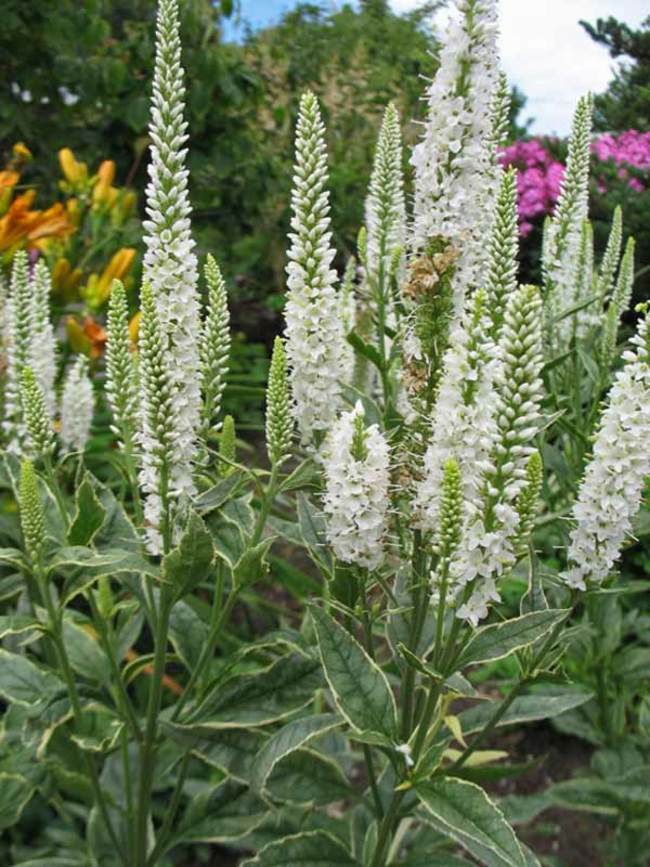

After a couple of weeks, when the roots appear, the cutting can be moved into open ground. If you did not use water for germination, but soil, then it is advisable to transplant the plant to a flower bed with it.
Before the first frost, the plant will have time to take root and will delight you with gorgeous flowers in the spring.
Growing Veronica
Even with all the unpretentiousness of this plant, caring for Veronica in winter should include moderate watering
, because otherwise, with waterlogging, there is a danger of its death. It is not that difficult to care for this flower, as you can use any soil. Veronica feels most comfortable at a temperature of 14-20 degrees.
There are many varieties that can grow well during dry periods of summer. The highest demand for moisture is in the spring, before the flowering period.At the moment when the first flowers begin to open, watering is reduced. When the last perennial flower of Veronica withers, the aerial part of the plant is pruned. This measure will stimulate the formation of new young leaves. Therefore, this procedure allows you to ensure the aesthetics of the plant throughout the spring-summer period and autumn.
Reproduction methods
To get new plants of Veronica, you can use the following breeding methods:
- division of the rhizome;
- cuttings;
- sowing seeds.
As a rule, when growing spikelet veronica, gardeners prefer the method that suits them best. Sowing seeds in a permanent place is best in the fall. However, you can do this in the spring, but first you have to carry out the operation of hardening the planting material - stratification. For grafting, the most favorable moment is created in the summer. It is necessary here prepare young tops of the stems
... Subsequently, they are placed in rooting soil or water to stimulate the root formation process. At the moment when a well-developed root system is formed in the plants, transplantation can be carried out in open ground.
However, most often new veronica bushes are obtained by plants by dividing the rhizome. The popularity of this method is due not only to the minimum investment of time, but also to the highest survival rate in a new place. It is recommended to do this in the spring or early fall. First you need to remove the ground stems, after which the perennial plant is dug up. For the operation of dividing the rhizome, you can use a knife or shovel. It is important to divide the plants into even parts so that the first cut off root contains at least 3 shoots. Upon completion of the division, it is important to immediately transplant to a new location.
Care
As you can see in the photo, Veronica's flowers are very beautiful and graceful. But in order for them to be like that, you will have to try, spend time and effort on caring for them.
Fortunately, in general, the plant is quite unpretentious. It feels great in sunny places and in partial shade, it is not afraid of wind and excessive heat. Most varieties are drought tolerant - they don't even need to be watered! The only exception is the flowering period. Lack of moisture will cause the flowers to fall off. However, if it rains heavily at least once a week, you won't have to water it by hand.
When flowering is complete, you need to wait a couple of weeks and cut off the stems. New ones will appear rather quickly - the set of green mass is very rapid. But after a few weeks of rest, the root system will become more powerful, which will have a positive effect on the life of the plant, its frost resistance.
Agrotechnics
The plant is unpretentious, therefore special skills in growing these flowers are not required. Veronica threadlike (or creeping) is able to adapt to growing in any conditions. The grass is unpretentious to the ground. Most species of Veronica are moisture-loving plants, but they take a short drought calmly and easily tolerate it.
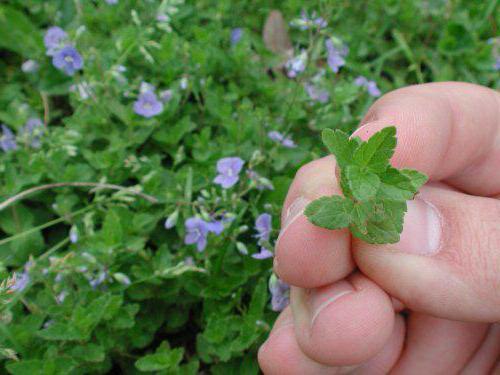

In Russia, the plant survives easily, being frost-resistant and easily tolerating severe Russian frosts. Although some of the species are more delicate, for example, Veronica branched. There is a need to cover them for the winter with spruce branches.
Important! Shoots are cut and removed only after the plant has finished flowering.
After planting the plants, periodically weed the flowers, otherwise they will run wild. Fertilize Veronica twice a season.
Dangerous pests
Usually Veronica is not attacked by pests, but sometimes you have to fight with them.
The most common problem is caterpillar attack - they simply eat young shoots and foliage. The problem can be solved by timely weeding, warming up the soil and stopping watering.
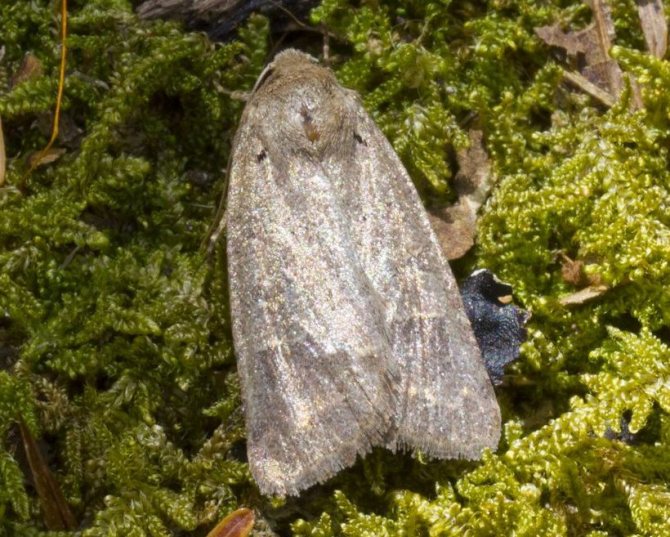

Much less often flowers are attacked by the scoop, long-wattled moth and moth. The problem is usually solved by treating the bushes with suitable insecticides.
Accustomed to life in the wild, Veronica easily resists infections. However, due to a lack of sun and excessively moist soil, a gray bloom may appear on the leaves - downy mildew. To cure the plant, a special fungicidal solution is made. For this, you can use drugs such as "Gamair", "Fitosporin". Usually, a single treatment will completely solve the problem.
General information about the plant
Veronica is a very common plant, the varieties of which are represented in different countries of the world. This can be explained by its unpretentiousness and drought resistance, which is why it manages to survive in any climatic conditions. The plant is undemanding to the soil, so it feels comfortable as on sandy and clayey
, and on loose and marshy ground. At first, it adorned forests, fields and mountains, but after a while they began to use it for decorative purposes for growing in flower beds.
When Veronica became a cultivated plant, it served as the basis for the development of new varieties adapted for ornamental gardening.
However, a man met Veronica creeping a long time ago, and at that time she was of value to him because of her medicinal properties. There are several hypotheses about the origin of the name Veronica. Perhaps this is due to the Greek word, which translates as "little oak", or Latin, which means "real medicine" or "genuine plant." There is also such a version that it got its name in honor of Saint Veronica.
The genus of this plant is quite numerous and includes more than 300 types
... But at the same time, he has very few representatives that can be used for growing in the garden.
However, the varieties bred for such purposes are very unpretentious in care and cultivation. After all, Veronica not only successfully tolerates any weather whims, but also blooms for quite a long time and can grow in various forms. Moreover, among them there are varieties that are most often used for decorative purposes:
Veronica medicinal
Veronica Steller
- in vivo, this variety is most common in China and Japan;
- being a stunted plant, it can grow up to 25 cm, the top is decorated with inflorescences;
- during the growing season forms straight, upright stems with pubescence. The characteristic shape of the leaves is ovate with a serrated edge, reaching 3 cm in length;
- has shortened inflorescences that resemble spikelets. In the first weeks of flowering, the ear is dense, but subsequently becomes looser;
- during the flowering of this variety, flowers are formed that have a blue or purple tint;
- flowering begins in July and lasts until autumn;
Veronica creeping
Veronica armenian
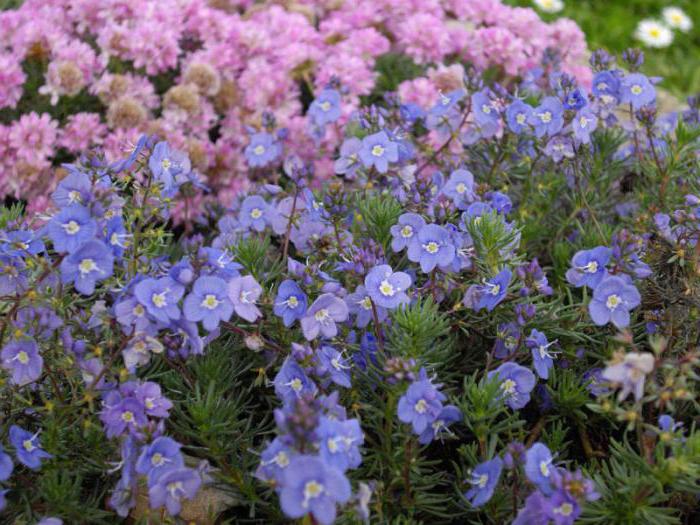

A short plant (7-10 cm) of bright green color, forming a dense and dense turf. Stems ascending or recumbent, woody at the base. Leaves 08-1.2 cm long, pinnately dissected at the base into thin and curling lobes, are decorative. The corolla of the flower is pale blue or lilac with a rich aroma. A pink variety was bred. Armenian veronica is a very drought-resistant, unpretentious plant, and therefore is popular with flower growers when decorating lawns, alpine slides, and terraces. Flowering begins in mid-summer. The species is very sensitive to the ground. Only rocky substrates with an alkaline environment and a small amount of river sand or fertilized clay are acceptable.
Veronica spicata varieties
Breeders have bred many varieties that differ in corolla color and morphological features.
Information about them is collected in the following table.
| Variety name | Height | Morphological features | Requirements for agricultural technology |
| Rotfuchs | Not higher than 45 cm | The variety has several stems that form a compact bush. They are erect, densely covered with green leaves with a shiny surface. It blooms with pink spike-shaped inflorescences from July | Prefers sunny locations and loose, nutritious soil |
| Heidekind | 30-40 cm | Straight stems form a lush bush. The shoots are covered with leaves of an oblong shape and a matte-gray shade. Raspberry flowers in dense ears. The plant blooms from mid-June for 30 days | The variety does not like excessive moisture, prefers lighted places with drained soil |
| Alba | 30-50 cm | Straight stems with oblong leaves. On the tops of the shoots there are ears of snow-white flowers. Pleases the variety with paints from the third decade of June to August | Veronica of this variety loves the sun, and is undemanding to the fertility and quality of the soil. |
| Veronica blue | Height up to 60 cm | Strong erect stems form a voluminous bush. Apical spike-shaped inflorescences of blue flowers. It begins to bloom in June | The variety is undemanding to moisture, soil fertility, prefers sunny places |
| Iceicle | 45-60 cm | Shoots are often solitary with ovoid light green leaves. White flowers are collected in ears | Prefers loose soils and well-lit areas |
| Blue Bouquet | 30-40 cm | Erect stems with lanceolate leaves with serrated edges. Corolla is dark blue, flowers form apical, dense inflorescences. Dissolve from the second decade of June | Loves loose soils, open places, resistant to lack of moisture |
All varieties of Veronica spicata are suitable for decorating rocky hills, curbs, look great near small artificial reservoirs.
Veronica small
Highly decorative species, picky about growing conditions. It is subendemic and grows in nature only on volcanic soils. Forms dense cushions with dark green leaves, completely covered with small blue flowers of a pure shade and with a delicate aroma. In a garden, reproduction is possible only by dividing the rhizome. Veronica shallow requires nutritious soil, but in the complete absence of organic matter, constant moderate moisture and good lighting (sunny places) are needed.
Reproduction
Veronica reproduces by seeds, root division and cuttings.
It is convenient to sow seeds before winter in October. The bed is prepared from loose (with a large proportion of sand), weed-free soil.
Spring sowing of Veronica is possible, after the obligatory processing of seeds with cold (stratification). Veronica's seeds are placed in a damp cloth and put into the refrigerator, in the vegetable compartment, for a month and a half. After that, the seeds are placed in seedling boxes, in loose soil from a mixture of sand, peat and garden soil. Small seeds are not buried, but only slightly sprinkled with soil.
Seedlings of Veronica are watered moderately, avoiding waterlogging of the soil. The temperature is maintained at +16 +18 degrees. Young plants are planted in the ground in May, with the onset of warm weather. Veronica will bloom in the second year.
Cuttings are harvested in summer by cutting off the tops of the stems. The twigs are dipped in slices in Kornevin, and placed on a prepared bed with loose soil. The plantings are shaded and covered with a mini greenhouse (film on arcs or cut plastic bottles for each stalk). Caring for cuttings consists of watering, airing, loosening the soil. The seedlings are transferred to a permanent place next spring.
By dividing the bush, Veronica is propagated in the spring, when the plant has just started to grow after hibernation. The bush is carefully dug up, and divided into parts using a sharp knife or shovel. The strip should contain at least 3 stem buds. Rhizomes are planted without deepening the buds of growth. The distance between plants should be between 25 and 50 cm, depending on the variety.
It is easy to plant Veronica filamentous by simply cutting off and digging out the rooted parts of the plant.Its creeping stems form roots in the axils of the leaves, which cling to the ground, thus, the plant grows in breadth. Layers take root in a new place quickly.
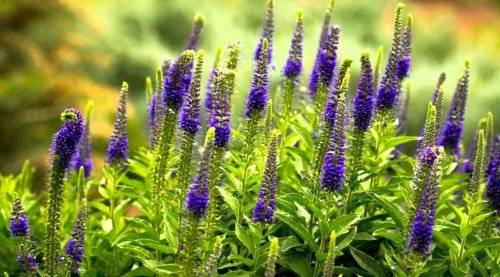

Rod Veronica: description
This genus is the most numerous (about 500 species) among the Plantain family. Among it are annual and perennial herbaceous plants, less often half-shrubs, which are common in all parts of the world, but mainly in the temperate and cold regions of Eurasia. Representatives of the genus are widespread in our country.
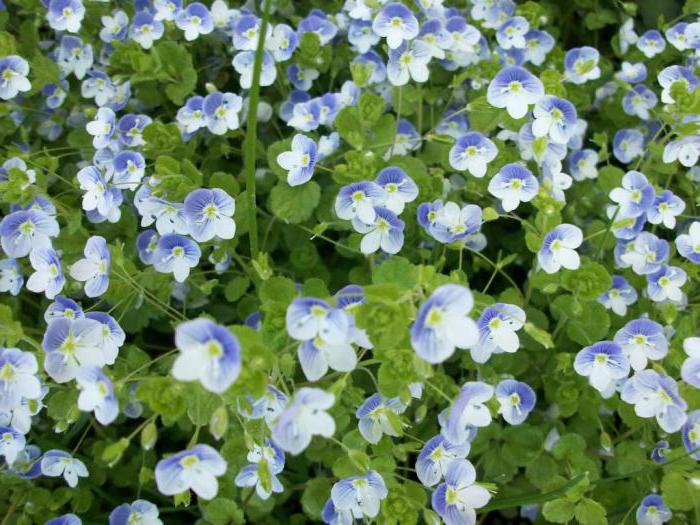

Any Veronica is a plant with characteristic generic characteristics. The first of them is small flowers with two stamens, which are collected in paniculate, spike-shaped or umbellate inflorescences (sessile or on a long peduncle). The second is thick rhizomes, shortened or branched, or many thin roots. Among the numerous representatives there are excellent honey plants, medicinal plants, as well as decorative ones. We will pay more attention to the latter.
It should be noted that Veronica is a plant, although it does not have outstanding external characteristics, but it is beautiful in its simplicity. Small flowers can rise above the flower bed, gathered in a slender ear, or almost creep in a soft "pillow", braiding everything around. We invite you to learn about the main types of Veronica introduced into the culture.
Siberian Veronichnik, Siberian Veronica
Eastern Siberia, Far East, China, Mongolia, Korea, Japan
forests, meadows, in the mountains up to an altitude of 2500 m above sea level
prefers moist soils
small, reddish-violet, purple, pink or white, with corollas 5-7 mm long and protruding stamens
spicate, up to 30 cm long, solitary, sometimes several
broadly lanceolate, 8-15 cm long and 1.5-4.5 cm wide, finely serrate along the edge, collected in whorls of 4-6 around the stem
straight, simple, glabrous or rarely villous, with multicellular hairs
fruits - egg-shaped capsules up to 3.5 mm long, with ellipsoidal seeds
slender, upright poly-stemmed plant
Veronica sibirica is one of the plants of the family called norichnikovye, in Latin the name of this plant sounds as follows: Veronica sibirica L. As for the name of the family of this plant itself, in Latin it will sound like this: Scrophulariaceae Juss.
Description of veronica siberian
A plant such as Veronica siberian is a perennial herb. Under natural conditions, this plant can be found not only in Eastern and Western Siberia, but also in the Far East of Russia.
Description of the medicinal properties of Veronica siberian
Veronica siberian is characterized by very valuable medicinal properties and finds itself quite widely used in medicine. It is noteworthy that for medicinal purposes it is recommended to use both the leaves and rhizomes of the Siberian Veronica. The concept of grass should include flowers, leaves and stems of a plant. Such healing properties are explained by the fact that saponins are found in the rhizomes of this plant, and coumarins were found in the leaves. In addition, the herb of Veronica siberian contains about seventy milligrams of ascorbic acid. As for traditional medicine, a decoction prepared on the basis of rhizomes and herbs of Veronica Siberian is very widely used here. Such a remedy is recommended for use in bloody diarrhea and enterocolitis, which will also be accompanied by diarrhea. In addition, traditional medicine considers the rhizomes of Veronica Siberian to be an extremely effective means for expelling tapeworm. In Tibetan medicine, the roots of this plant are widespread in jaundice and gastroenteritis, as well as in endometritis as a hemostatic agent.As for Chinese medicine, everything is exactly the opposite: it is believed that a decoction obtained on the basis of the roots of Veronica siberian is capable of causing menstruation. In addition, such a decoction is also used as a diuretic, this decoction is also effective for paralysis, gout, constipation and beriberi. As for the infusion and decoction, made on the basis of the herb Veronica Siberian, such remedies, according to folk medicine, are effective antipyretics for a variety of colds. Fresh leaves of this plant should be applied to the feet to reduce sweaty feet. Also, fresh leaves of Veronica siberian can also be used as wound healing agents for rheumatism. Veronica Sibirskaya has also found its application in homeopathy: here an infusion prepared on the basis of the rhizomes of this plant is used not only as a laxative, but also as a pain reliever. With bloody diarrhea and enterocolitis, it is recommended to use a decoction based on Veronica siberian three times a day, two tablespoons. To prepare such a decoction, you will need to take two teaspoons of dry rhizomes and herbs of Veronica Siberian in equal proportions to one glass of water, after which the resulting mixture is boiled for five to six minutes, then infused for one hour, and then filtered. With a variety of colds of varying severity, as well as with bronchitis, it is recommended to prepare a decoction of this plant, which is recommended to be taken three times a day, about one third of a glass. To prepare such a remedy, you will need to take one teaspoon of dry Veronica siberian herb for one glass of boiling water. After that, it is recommended to infuse the resulting mixture for two hours, and then strain it thoroughly. Now such a decoction is ready for use: if all instructions are followed, a very effective result is guaranteed.
A plant resistant to harsh winters, Veronica is grown both for decorative purposes and for the preparation of medicinal broths. In total, more than 500 species are known for garden planting. There is no such diversity in nature, but there are also many wild species. There are perennial, annual and shrub species, each of which is diluted with varietal diversity.
Use in design
Blooming Veronica Very beautiful and decorative. Landscape designers around the world are actively using it in various forms:
- To decorate flower beds in any place - from private houses to parks, offices, enterprises.
- It looks great as a background plant for ground cover flowers.
- Looks beautiful with geraniums, peonies, carnations, highlander.
- Cut and properly dried, Veronica's flowers can last for years. Very beautiful dried compositions are obtained from them.
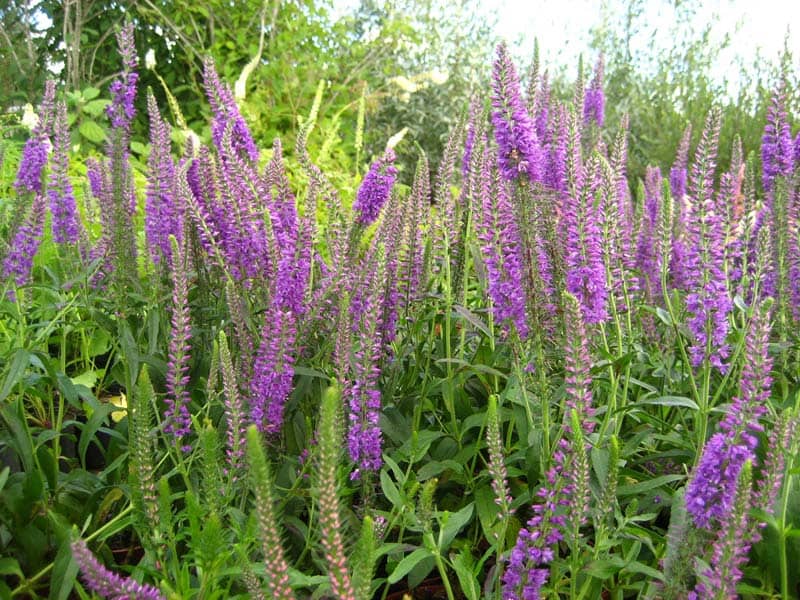

Description of the veronica flower
Veronica (Veronica) is a culture from the Plantaginaceae family, which was previously included in the Scrophulariaceae family. Veronica is considered a one-year or perennial plant, sometimes it grows as a half-shrub, which can be twisted all over the world.
Most of the species are known in European and Asian countries, however, some of them are considered endangered and are listed in the Red Book. The family of Veronica became known in ancient times, however, in our time there is no single point of view on the emergence of its scientific nomination.
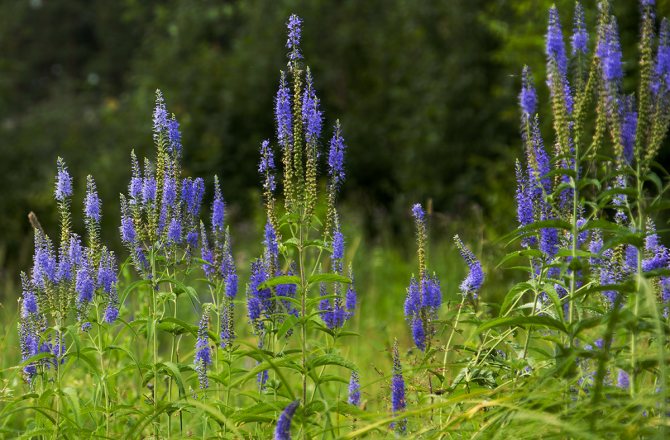

Some scholars believe that this is the genus called by Leonart Fuchs in honor of St. Veronica, and the rest introduce the name to the combination of the Latin words “vera unica”, which translates as “truly the only”, that is, a true remedy for most diseases. Seriously, certain types of Veronica are characterized by personal healing qualities and are still used in traditional medicine. And a number of scientists translate the name from Greek as “small or low oak”.
It is a very popular plant, the varieties of which are unpretentious, stable to the dry period, which provides the ability to survive in various climatic zones.
Veronica has straight or creeping stems. The leaves are whorled, diverse in shape, opposite or alternate arrangement. Flowers form lateral or crown inflorescences. In color, they are sometimes snow-white, azure, blue, pink.
Veronica's application
Veronica officinalis, in addition to its attractive appearance, is rich in vitamins and other useful substances. Its infusions are used to gargle with sore throat, decoctions are drunk for diseases of the kidneys, gallbladder. Outwardly, infusions of Veronica are used to treat fungus, ulcers, eczema.
Young veronica leaves are used for food, as a seasoning for meat and fish, in salads. They taste like watercress.
Other types of Veronica also have medicinal properties, albeit to a lesser extent. The collection of plants for medicinal purposes is carried out at the beginning of summer. Raw materials are dried in the shade, at a temperature of +40 degrees (you can use electric dryers).
Veronica long-leaved is a wonderful honey plant. It can be planted in an orchard to attract bees.
In decorative gardening, tall varieties of Veronica are used as vertical accents in mixed flower beds, planted in separate groups on the lawn, and decorate the walls of buildings or fences with them. Plants look beautiful, planted in the form of a hedge, along the path.
In mixed plantings, bright "candles" of blooming Veronica look harmoniously with large chamomiles, daylilies, yarrows, cereals, echinacea, calendula. Veronica varieties with blue and purple inflorescences are ideally combined with white and yellow flowers.
Low-growing Veronica is planted on alpine hills, retaining walls are decorated with it, planting right in the cracks between the stones. Veronica is irreplaceable in rocky gardens.
Possessing tenacious and branched roots, Veronica “holds” the soil well, it is planted with it on slopes and shores of reservoirs. The filamentous Veronica looks good in a flowerpot or flowerpot, its long shoots, strewn with flowers, hang beautifully from the pot.
Watch also a video on the topic:
Veronica plant species and reproduction
Another rather large and not very widely known species is Veronica gentian or Kemularia. This plant has leathery, thick, rounded-lanceolate leaves up to fifteen centimeters long, collected in basal rosettes.
The variegated form of Gentian Veronica - Variegata is especially good. Over time, whole clumps of such outlets are formed that are not connected to each other. Most of the leaves from the rosettes hibernate, and new ones begin to grow in the period from April to May. A little later, peduncles from thirty to eighty centimeters high, rarely covered with small leaves, appear above the rosettes.
At the end of May, graceful brushes of rather large, like for Veronica, about a centimeter in diameter, white-blue flowers with blue veins, bloom on the peduncles. Veronica gentian blooms for two to three weeks until mid-June.
Veronica gentian is a long-rhizome plant. When, after flowering, young daughter rosettes are formed at the ends of the stolons, the mother plant dies off. Therefore, in the winter, several independent outlets leave.
Kemularia is unpretentious: it is photophilous, but it will grow in partial shade without any problems. It develops well on almost any well-drained soil, including limestone. Since this veronica grows wild in wet mountain meadows, do not forget to water it in the garden.
Veronica gentian seeds are propagated vegetatively. They can be sown before winter or in spring directly into open ground or sown in spring for seedlings. And you can also cut off a piece of rhizome with roots in spring or autumn and plant it in a new place.
Veronica gentian is planted in the foregrounds of mixborders, separate clumps are created from plants, large rockeries are decorated with it, especially those that are near water bodies.
to the table of contents
Description of the plant veronica veronica, origin
Veronica is difficult to confuse with other plants due to the combination of signs of nettle, plantain and bluebells. If you look at Veronica from afar, then she does not differ in brightness, but resembles a solid carpet. Therefore, when creating a garden decor, they use not one plant, but several at once, diluting the green mass with bright spots. Root system
... Each type of Veronica has its own differences in the type of rhizomes:
- filiform with a surface arrangement;
- thick with shallow germination;
- thin mesh, occupying a large underground area.
Perennial bushes
have a solid root that can withstand cold winter temperatures.
Annual species
differ in more delicate roots: filiform and superficial.
Stems
... Veronica has a long, dense, cylindrical stem. Some species have an erect ground part, others a creeping one. Depending on the location of the stems, the plant has its decorative value. Strong interlacing of fibers allows to withstand weight loads during walking of a person or animals. It will not work to break off or tear off part of the bush, only with the use of a tool.
Leaves
... Externally, the leaf plate resembles a nettle: oval with a carved edge, have small hairs. Unlike nettle, it does not leave burns, it behaves friendly. The color scheme of green mass is mostly bright green, although there are gray specimens. The leaves are located on the stem alternately or oppositely, rarely whorls.
Flowers
... The natural color is deep blue, in the garden culture you can find white, blue, lilac, purple shades. The inflorescence is a spikelet with a dense arrangement of small flowers on it, bell-shaped with a carved edge. They bloom alternately from bottom to top, so the flowering is long. The lower ones form capsules with seeds, while the upper ones continue their flowering.
For their own, the people call the grass snake or Veronikova grass. In fiction, you can find the name "goat's face" or "blue". Some species are similar to forget-me-nots, so this name also stuck with Veronica.
All garden varieties are derived from wild species. The combination of decorative properties and natural endurance made the species the most numerous in the plantain family.
Caring for Veronica spicata: features and recommendations
Not capricious Veronica is convenient in that it requires minimal care and attention, practically does not get sick and does not need additional feeding and winter shelter.
- Watering is carried out as needed, without moisture stagnation. It is especially important to moisten the soil before the flowering period and at the stage of seedling germination. The rest of the time, watering is moderate, not frequent. Veronica tolerates short-term drought well.
- Mulching the soil around the plant will allow you to keep the moderate humid microclimate of the soil for longer without additional watering. In addition, the mulch layer prevents the growth of weeds in the flower bed.


- Veronica spicate is resistant to diseases and pests. Only in rainy weather or excessive humidity can it become infected with powdery mildew, spotting or rust. If characteristic signs (spots, plaque) appear on the leaves, the whole plant is treated with a fungicidal agent (for example, Fundazol). If aphids appear on the plant, the perennial should be treated with an insecticidal agent (Tanrek, Aktara).
- With a sufficiently fertile soil, additional fertilizing, the culture does not need. In poor soils, it is better to apply mineral and organic fertilizers.
- If the varieties of Veronica spicata are tall enough, it is necessary to tie the plant to a support.
- After flowering, the aerial part is cut off so that new green shoots with foliage appear. In this way, you can preserve the attractive decorative appearance of the bush until autumn. Before wintering, the bush is cut off again, leaving 3-5 cm.To prevent infection of the plant with pathogenic bacteria, you should also constantly cut off the faded inflorescences.
- Every 5 years, you need to rejuvenate the Veronica bush, dividing it into several parts. Delenki will be able to actively develop and grow "with renewed vigor."
- For the winter, the plant does not need to be covered with anything, it perfectly tolerates low temperatures, and even harsh Russian winters.
Veronica spikelet
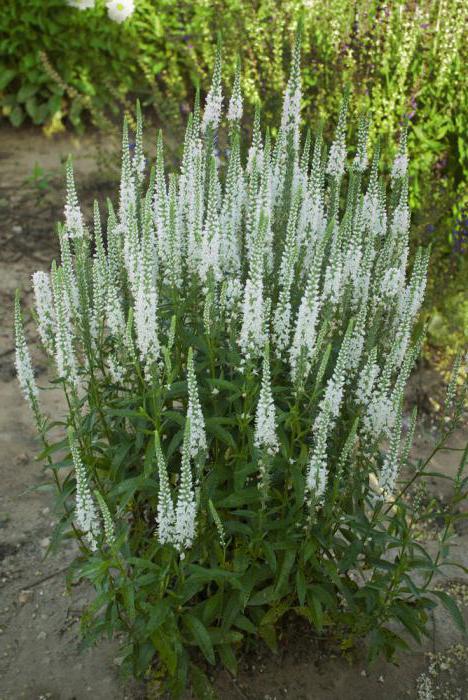

One of the most decorative species with a large number of bred varieties. Plant up to 40 cm in height with few single stems. Especially beautiful are the apical racemose dense inflorescences of saturated blue, blue, violet shades, less often white. The species has been introduced into culture since 1570. Long flowering from mid-summer, gives a lot of seeds, multiplies well by self-sowing. Any garden soil is suitable for its cultivation. Spikelet Veronica is a winter-hardy, drought-resistant, light- and moisture-loving plant. Looks especially good in single landings. Examples of varieties: Romiley Purple (deep purple), Barcarolle (pink), Heidekind (raspberry pink), Rotfishs (cream), White Icicle (white, pictured).
Planting and leaving
This flower belongs to the unpretentious type, but moderate watering will not harm it. Especially in dry spring before flowering. Watering is recommended to be done with warm, settled water. Excessive moisture can kill the plant.
Herbaceous sprawling species do not tolerate droughts, stop blooming and may die. High grades easily endure the heat. Veronica gray-haired survives if it loses most of its moisture. The most resistant to drought is small-fruited. Filamentous, gentian, prostrate Veronica love damp soil, but tolerate dry times. Any novice florist can easily cope with caring for this plant.
Absolutely any soil is suitable, but loamy soil is better. The flower feels great in open sunny areas, but it copes well with shading. It should be said that the shade and partial shade will not allow all the decorative properties of the plant to unfold.
When the flower fades, it is pruned to make the flower beds attractive. Pruning also provides an impetus for the growth of fresh foliage.
Veronica requires almost no fertilization or feeding. If the soil is very poor, this can be done once every two to three years.
You need to feed it with organic fertilizers in the form of peat, manure.
Wintering
Veronica tolerates frost well and does not need shelter. Peat or humus can be added to the roots, which will only improve the quality of the soil, and the ground part is cut off completely.
Branched and woody species require protection from extreme cold.
Neighborhood with other colors
A flower looks beautiful with different plants in a flower bed: roses, lilies, chamomiles. Looks good and elegant in a completely finished flower garden, fits into it. It is also good for decorating the banks of reservoirs and small ponds. Veronica rurauchnaya grows on the water and floats on the surface. A small disadvantage of tall flowers is that they must be tied up so that the bush looks aesthetically pleasing and beautiful. Low-growing ones are renewed by removing faded inflorescences and the appearance of fresh ones, which give the flower an attractive appearance all season.
Veronica growing from seed, dividing the bush, cuttings
Veronica is most often propagated by seeds - it is not difficult to grow it from seeds. If there are not many seeds, it is advisable to sow them for seedlings. Having grown even one big bush of Veronica, you will be able to collect and sow your seeds in the future - Veronica ties their flower well, they ripen in September.
Seeds can be sown directly into the ground in fall or spring.Veronica large is also often propagated by dividing the bush: they do it either in the spring, as soon as the plant starts to grow, or in the autumn periods, September-early October.
Experienced flower growers propagate royal veronica with green cuttings, which are cut from the tops of young spring shoots before flowering.
Usually, a large Veronica flower is planted in a mixborder, where it perfectly sets off plants with large and bright flowers. However, I believe that the beauty of the Royal Veronica is more expressive if she grows solo, for example on the lawn. Inflorescences of Veronica large can also be used for cutting.
to the table of contents
Popular species and varieties
According to various sources, there are from 300 to 500 different species of Veronica, mainly growing in cool and temperate zones.
- V. Dubravnaya
(V. chamaedrys) is a perennial. The stem has two rows of fine hairs. The leaves are rounded, up to 3 cm long and 1.5 cm wide. The flowers are large compared to the overall size of the plant, and are bright blue in color. Height no more than 40 cm. Rhizome - thin, creeping. Can be found in European gardens and Siberia. - B. medicinal
(V. officinalis) is a perennial plant. The flowers are blue or pink. The corolla is funnel-shaped. Flowering is observed throughout the summer. Previously used for medicinal purposes. Grows in mixed forests and forest park areas. - B. field
(V. arvensis) is an annual or biennial herb. Height is not more than 30 cm. Leaves are crenate, whole-edged. The flowers are blue or white, small in size, collected in pubescent racemes. Grows in fields and mountain slopes. Blooms in May or early June. It is a medicinal plant. Used for rhinitis, cough, skin diseases, laryngitis, etc. - B. filiform
(V. filiformis) - perennial, no more than 5 cm in height. Stems are thin, spread along the ground. Leaves are light green in color, rounded. The flowers are light blue or white. Flowering occurs from April to June. Ideal for creating a floral carpet. - V. large
(V. Teucrium) is a rhizome variety of Veronica. About 0.7 m in height. Leaves are bare from above, with few hairs in the lower part. Flowers of a bright blue hue, collected in a brush. Not afraid of frost. Varieties - True Blue, Miffy Blue, Schirly Blue. - V. gentian
(V. gentianoides Vahl). Inhabits Russian latitudes, Crimea and Central Asia. You can also find it in the Caucasus. Rosette leaves and very few of them. The flowers are pale, blue and white. It has been grown since the 18th century. Variegata, Tessington White. - V. spike
(V. spicata L.). Grows in Russia, the Caucasus, Asia and the Mediterranean. Flowers come in a variety of colors, from white to purple. Flowering lasts about 1.5 months. Stems are solitary. Suitable for planting in flower beds. Varieties - Romily Purple, Blue Peter, Barcarolla, Red Fox, Haydekind, Rotfish, Iceicle and White Iceicle.

